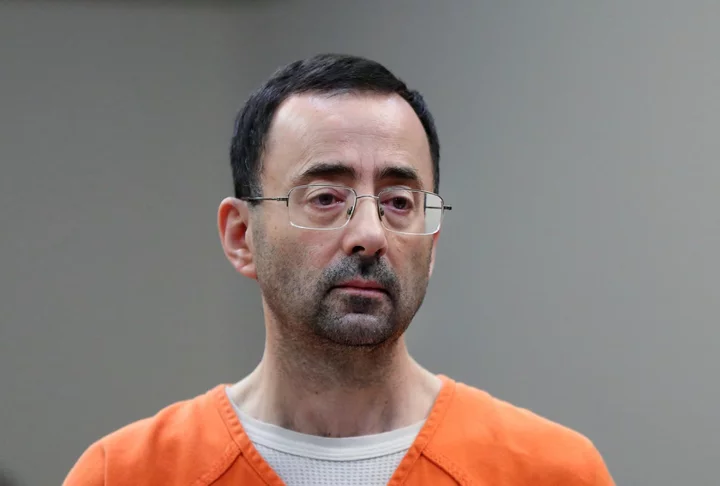
Victims of Larry Nassar sue university over alleged ‘secret decisions’ in sex abuser’s case
Victims of convicted sex offender and former Michigan State University sports doctor Larry Nassar have sued the college over allegations that officials made “secret decisions” against releasing documents in the case. The women and their relatives have accused MSU of holding secret votes that led to the university’s refusal to hand over more than 6,000 documents to Michigan Attorney General Dana Nessel‘s office. Ms Nessell led an investigation into what the school knew about the abuse perpetrated by Nassar, but the probe ended in 2021 because the university didn’t provide documents related to the scandal. The victims said they are not seeking money in the suit filed on Thursday. Instead, they said they want accountability from the university and its elected trustee board. “We contend that board members made a behind-closed-doors secret decision not to release the records in blatant violation of the Open Meetings Act,” Azzam Elder, an attorney representing the victims, said in a press release. “They followed that up with violations of the Freedom of Information Act when we requested emails that might show they discussed and made a closed-door decision on the matter in violation of law.” Nassar has admitted to molesting some of the US’s top gymnasts under the guise of medical treatment. The disgraced doctor was convicted in 2018 to 40 to 175 years in prison over ten counts of first-degree criminal sexual conduct and possession of child sexual abuse images. At the time the accusations against him emerged in 2016, Nassar had been employed by MSU for more than two decades, with some of the athletes who were molested alleging they reported the abuse since the 90s. MSU did not immediately respond to The Independent’s request for comment. In the past, the university has cited attorney-client privilege as the reason they refused to release documents in the case. “This is about who knew what, when at the university,” victim Melissa Brown Hudecz told the Associated Press ahead of Thursday’s lawsuit filing. “We can’t heal as a community until we know that everyone who enabled a predator is accountable. By protecting the 6,000 secret documents and anyone named in them, the board is adding to survivors’ trauma with their lack of institutional accountability.” The lawsuit comes just days after Nassar was stabbed multiple times by another prisoner in a federal prison in Florida. The prisoner who stabbed Nassar said that he responded with violence following alleged comments made by Nassar that “he wanted to see girls play in the Wimbledon women’s tennis match,” according to the AP. Read More Formed to combat Olympic sex abuse, SafeSport center is struggling 6 years after opening Michigan urologist to stand trial on sexual assault charges connected to youth hockey physicals Woman left topless in prison cell accuses police of sexual assault as hours of footage ‘missing’
2023-07-30 05:16
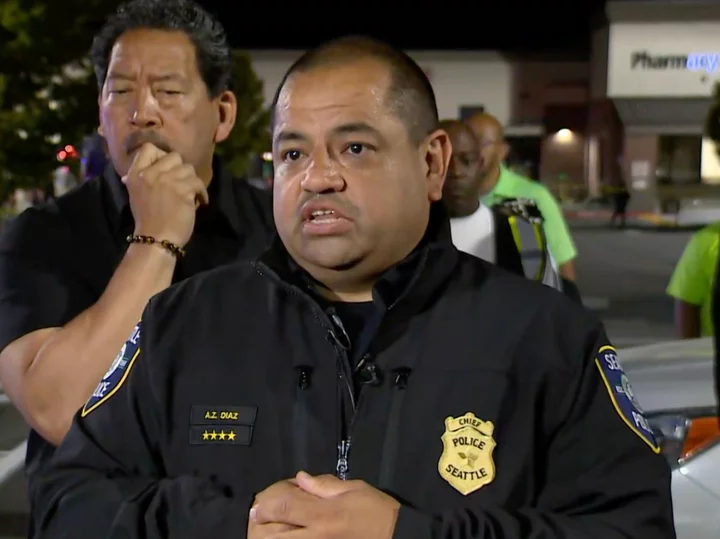
Mass shooting at youth community event in Seattle leaves five injured, two critically
Five people were injured during a Friday mass shooting in Seattle. The violence unfolded during a community event, Seattle Police Department Chief Adrian Diaz said during a press conference. Four of the victims were males and one of them was a female. Authorities said it is unclear at this time whether the shooting was targeted. “We know that there’s dozens and dozens of rounds that were fired,” Mr Diaz said. “We have five victims. Two are in critical condition. Three appear to be stable.” The chief of police said this year the department has recovered the highest number of guns in 15 years. “The gun violence issues that we have in our city, we’ve seen it rise and sometimes slow down at times, but right now we’ve really got to get guns off our streets,” he said. Read More Video captures police confronting white woman moments after she shot Black neighbour in row over children playing
2023-07-29 21:55
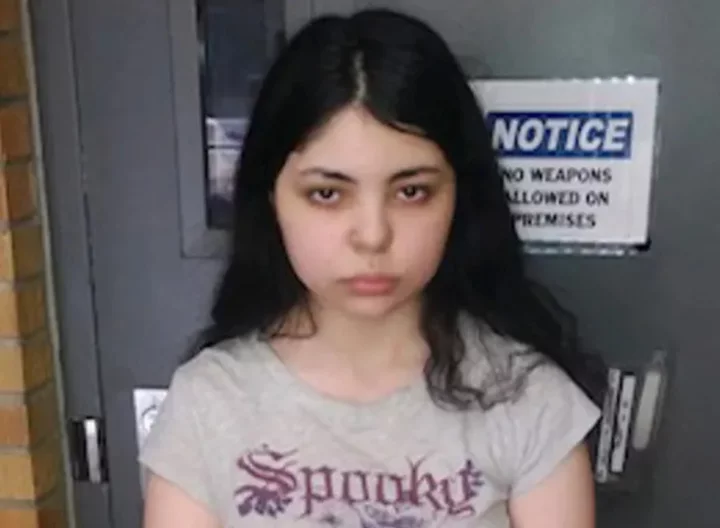
Alicia Navarro tells investigators ‘nobody hurt me’ in mysterious reappearance as police deny arrest rumours
A missing Arizona teenager who mysteriously turned up at a Montana police station four years after her disappearance has told police that she was not harmed, according to a video released by police. Alicia Navarro, 18, stunned officers in the small town of Havre, 40 miles from the Canadian border, when she showed up alone on Sunday and identified herself as a missing teenager from the Phoenix suburb of Glendale. Nearly a week on from her reappearance, very little is known about where the teenager has been, or if any suspects have been identified. In a newly released video interview, a Glendale detective asks Ms Navarro: “Did anybody hurt you in any way?” “No, no one hurt me,” she replied. The detective then asks: “OK, because our goal is we just want to make sure that you’re safe.” “I don’t, I don’t, ummm... I understand that,” she responds. In a separate video, Ms Navarro thanks police. “Thank you for offering help to me,” she says. Ms Navarro disappeared from her Glendale home in September 2019 at the age of 14, sparking a vast search operation involving police, the FBI and the Center for Missing and Exploited Children. Her mother Jessica Nuñez has previously said the teenager was on the autism spectrum, which made her shy in some social situations, and that she had left a note in her bedroom saying she had run away. “I will be back. I swear. I’m sorry,” she wrote in a note days before her 15th birthday, before taking her laptop and phone and hopping over a backyard fence. A private investigator hired by the family told the New York Post Ms Navarro had only spoken briefly to her mother. Trent Steel told the Post the family was thrilled she had been found safe, but that the teenager had “not made her intentions clear”. Glendale police Lt Scott Waite said this week that investigators were looking into all possible explanations for her disappearance, including kidnapping. Mr Waite described the teenager’s reunion with her mother as “emotionally overwhelming”. Ms Navarro reportedly apologised for “what she has put her mother through.” Ms Nuñez previously told 12News that she believed her daughter had been lured away by a predator. In a video posted to her Facebook account on Wednesday, Ms Nuñez told her thousands of followers: “I want to give glory to God for answering prayers and for this miracle.” In a statement released on Friday through the Anti-Predator Project, her family thanked law enforcement, activists and the media. “It is a blessing that after being missing for so long Alicia can come back home,” the statement reads. “If there is anything that Alicia’s story has taught us is that you can never give up hope.” According to the Associated Press, a man living in an apartment a few blocks from the Havre police station was arrested on Wednesday night. Witnesses told the AP that 10 heavily armed uniformed and undercover officers arrived at the address at about 8pm and took a suspect away in handcuffs. On Friday, Glendale police denied that there have been any arrests in connection with Ms Navarro’s disappearance. Read More Mystery as teenager walks into Montana police precinct four years after she went missing in Arizona Mother says daughter’s return after four years brings hope to all parents of missing children
2023-07-29 02:46

Jimmy Hoffa disappearance anniversary: What happened to long-lost union leader presumed murdered by the mob?
Jimmy Hoffa, the legendary American union organiser, disappeared from a parking lot outside of the Machus Red Fox restaurant in Bloomfield Township, Detroit, 48 years ago on Saturday 30 July 1975. Presumed dead since the same date in 1982, his body has never been found, no one has ever been charged and the case remains unsolved. Hoffa, 62, was last heard from at around 2.15pm that afternoon, calling his wife at their home in Lake Orion and a friend, Louis Linteau, at his office from a public payphone, griping that the two gentlemen he was supposed to be meeting for lunch had failed to show up. He was subsequently spotted talking to several other men nearby before being driven away in a maroon car that one eyewitness, a truck driver, told investigators could have been a Lincoln or maybe a Mercury Marquis. It might as well have been a hearse, for all the difference it made, for James Riddle Hoffa would never be seen again. His own vehicle, a green Pontiac Grand Ville, stood abandoned at the scene, just where he had left it. Long assumed to have been the victim of a mob hit, the visionary general president of the International Brotherhood of Teamsters (IBT) – who dramatically expanded the union’s reach, influence and coffers between 1957 and 1971, before being brought down by scandal – certainly had more than his fair share of powerful enemies and shady associates. Hoffa’s story – or, at least, versions of it – has frequently been told over the past half-century, often fictionalised through characters loosely based upon him in movies like Sergio Leone’s Once Upon a Time in America (1984) or more directly in Danny DeVito’s biopic Hoffa (1992) starring Jack Nicholson, James Ellroy’s Underworld USA novel sequence or Martin Scorcese’s recent The Irishman (2019) in which Al Pacino played the doomed labour leader. But none of those projects have come close to cracking one of the most enduring true crime mysteries in the history of American public life. What really happened to Jimmy Hoffa? Now that is a riddle. Born on Valentine’s Day 1913 in Brazil, Indiana, Hoffa’s Pennsylvania Dutch father John was a coal miner who passed away from lung disease in 1920 when his son was just seven years old, prompting the family to relocate to Detroit, Michigan, soon to become the epicentre of the mighty American auto industry. Realising he would need to grow up fast to support his mother, Hoffa left school at 14 to work as a stock boy for a grocery chain, where he soon took exception to the inadequate wages he received, the perilous terms of his employment and the inequality he saw all around him, which would only worsen in the aftermath of the Wall Street Crash of 1929 with the coming of the Great Depression. Having learned to stand up for himself against workplace injustice, Hoffa quit in 1932 to work as a professional organiser with the Local 299 chapter of the Teamsters union, representing Detroit’s truck drivers and warehouse operatives. As the organisation grew over the course of a combative decade, consolidating its power first locally, then regionally and finally nationally, Hoffa met the Polish girl who would become his wife, Josephine Poszywak, during a strike undertaken by non-unionised laundry workers in early 1937. They married that September. Hoffa’s growing reputation and networking smarts saw him named chairman of the Central States Drivers Council in 1940, president of the Michigan Conference of Teamsters in 1942 and then president of Local 299 by 1946, all without moving so much as a single truck himself. As a labour stalwart, Hoffa secured a draft deferment when the United States entered the Second World War by successfully arguing he would be of far greater service to his country organising industry at home than he might be deployed as a grunt abroad. That also meant he was well positioned to reap the spoils of the American economic boom of the Truman years. By 1952, he was appointed international vice president of the IBT, serving as deputy to Dave Beck, who was himself succeeding Daniel Tobin, who had led the union since way back in 1907. The IBT relocated its headquarters from Indianapolis to Washington, DC, three years later in order to be better placed to lobby Congress for its interests. It had never been more powerful. Then, in 1957, Beck was indicted, convicted and jailed on fraud charges after being hauled before John McClellan’s Senate Select Committee on Improper Activities in the Labour or Management Field. Hoffa was voted in as his successor as general president at the IBT’s convention in Miami Beach, Florida, that October. However, Hoffa’s profile within the labour movement had inevitably increased his exposure to organised crime and he had been arrested earlier that year for allegedly attempting to bribe a McClellan Committee aide, prompting the AFL-CIO to expel the Teamsters from its ranks in passionate opposition to his appointment. The air of notoriety surrounding Hoffa caught the attention of mob-busting US attorney general Robert F Kennedy during his brother’s presidency in the early 1960s and would see much of the organiser’s energies eaten up by legal scraps for much of that decade. He was indicted for jury tampering in Tennessee in May 1963 after again being accused of attempted bribery and was convicted the following March, sentenced to eight years in prison and a $10,000 fine. Four months later, while out on bail for the first offence, he was convicted at a second trial in Chicago, Illinois, on one count of conspiracy and three of mail and wire fraud for improper use of the Teamsters’ pension fund. This time he was sentenced to five years behind bars. After spending three years unsuccessfully appealing those convictions – while simultaneously expanding the union and bringing almost all on-road North American truck drivers together under one National Master Freight Agreement – Hoffa was sent to Lewisburg Federal Penitentiary in Pennsylvania on 7 March 1967 to serve a 13-year aggregate sentence. Despite the disgrace, he refused to resign and went on operating as IBT boss from Lewisburg, remaining in the role until 19 June 1971, when he was replaced by Frank Fitzsimmons, with whom he had a long association dating back to their Detroit days. Hoffa was released from prison on 23 December that year, having served fewer than five of his 13 years after Richard Nixon commuted his sentence on the condition that he refrain from engaging in union activity until 6 March 1980, a stipulation he was bitterly opposed to and battled in court in the hope of being able to wrestle back the Teamster’s presidency, unmoved to consider retirement by the generous pension settlement the organisation had handed him. The Mafia were among those opposed to his comeback ambitions, and one of their enforcers was Anthony “Tony Pro” Provenzano, a capo in New York City’s Genovese crime family with whom Hoffa had once been close but seemingly fallen out with while both men were incarcerated at Lewisburg. Provenzano is one of the men Hoffa is supposed to have been dining with at the Machus Red Fox on the day he vanished. The other was Anthony “Tony Jack” Giacalone, a local heavy who may have been dispatched as a mediator to oversee Hoffa’s appeal for support to Provenzano. Neither would admit to having seen the labour veteran in Bloomfield Township that day and both seemingly had credible alibis. What is known is that the car in which Hoffa is most likely to have been spirited away – a 1975 Mercury Marquis Brougham, after all – belonged to Giacalone’s son Joseph, who had lent it to one Charles “Chuckie” O’Brien, a Hoffa family friend. O’Brien may have been engaged to collect the old man in order to encourage a false sense of security. His fingerprints would later be found on a 7-Up bottle in Hoffa’s Pontiac, although he continued to deny any involvement until his death in 2020. When investigators examined the Mercury on 21 August, police dogs positively identified Hoffa’s scent in its upholstery, strongly suggesting he had ridden in it at least once. Later, in 2001, the advance of DNA technology enabled officers to locate a strand of his hair in the same car, although, again, that was not sufficient to trace it to a specific date. After years of federal investigation had resulted in 16,000 pages of documents spread over 70 volumes but no outcome, leaving Hoffa’s wife Josephine to pass away in 1980 without answers, the FBI’s opinion on what had happened would be outlined by Arthur Sloane in his book Hoffa (1991). In it, Sloane suggested the official verdict was that Northeastern Pennsylvania mob boss Russell Bufalino had ordered the hit and dispatched Thomas Andretta and the brothers Salvatore “Sally Bugs” and Gabriel Briguglio, alongside O’Brien, to carry it out. The quartet then either killed Hoffa inside the vehicle or drove him on to an unspecified location and executed him there, perhaps cremating his body to prevent its rediscovery. That broad outline was effectively confirmed on 16 June 2006 when The Detroit Free Press published the entire 56-page “Hoffex Memo”, an FBI dossier dating from January 1976 in which the bureau expressed its suspicions in writing, arguing the gangsters were concerned that a reinstated Hoffa might interfere with their control of the Teamster’s pension fund or even be persuaded to testify against them. There are numerous quibbles with that theory, however. Experts often argue that Hoffa was too high-profile a target for the mob to assassinate in such a public manner and that his hopes of returning to the leadership of the union amounted to little more than a pipedream by 1975, his name too tarnished to represent a serious threat. According to Sloane, former US prosecuting attorney Keith Corbett also believed that O’Brien was too unreliable to have played a part and that Vito “Billy” Giacalone, the younger brother of Tony Jack, was more likely to have been the fourth man. A completely fresh theory appeared in 2004 with the publication of Charles Brandt’s book I Heard You Paint Houses, the basis for Scorsese’s The Irishman, in which the author argues that hitman Frank Sheeran did the deed in an empty house in Detroit after Hoffa had been delivered into his clutches, the subject having confessed as much in old age. Bloodstains found on floorboards at the scene did not match Hoffa’s DNA, however, and it is often thought unlikely, as was the case with O’Brien, that an outsider might be trusted with such a delicate assignment by the notoriously tribal Italian-American syndicate. Another infamous mob killer, Richard “The Iceman” Kuklinski, claimed in his own 2006 memoir that he was responsible, having been paid the princely sum of $40,000 to whack Hoffa. Kuklinski claimed he drove the body to a New Jersey junkyard, sealed it inside a 50-gallon oil drum and set it on fire, later digging up the charred cadaver and placing it in the trunk of a car that was duly sold for scrap metal. That has likewise never been substantiated. As to the final resting place of Hoffa’s remains, multiple sites have been inspected over the decades without yielding a result, from the now-demolished Giants Stadium in East Rutherford (a tip-off hitman Donald “Tony the Greek” Frankos offered in a 1989 Playboy interview) to a landfill beneath the Pulaski Skyway in Jersey City and even the Renaissance Building in downtown Detroit, now the 73-storey home of General Motors. A farmer’s field, a swimming pool and a suburban driveway in Michigan have all been proposed and discarded while the wildest speculations imagine the missing man tossed from a plane by corrupt federal marshals into the Great Lakes (a theory courtesy of Hoffa bodyguard Joseph Franco, who had a book to sell) or ground up and disposed of in one of the quieter swamps of the Florida Everglades, an idea pitched to the Senate by self-described murderer Charles Allen in 1982. Sadly, we may never know the truth about how Jimmy Hoffa, at one time one of the most famous faces in America, came to vanish into thin air, blown away on the breeze like an old parking ticket, never to be seen again. Read More FBI say no sign of Jimmy Hoffa’s body under New Jersey bridge Events in the disappearance of former Teamsters head Jimmy Hoffa From serious to scurrilous, some of the many Jimmy Hoffa theories
2023-07-28 15:18
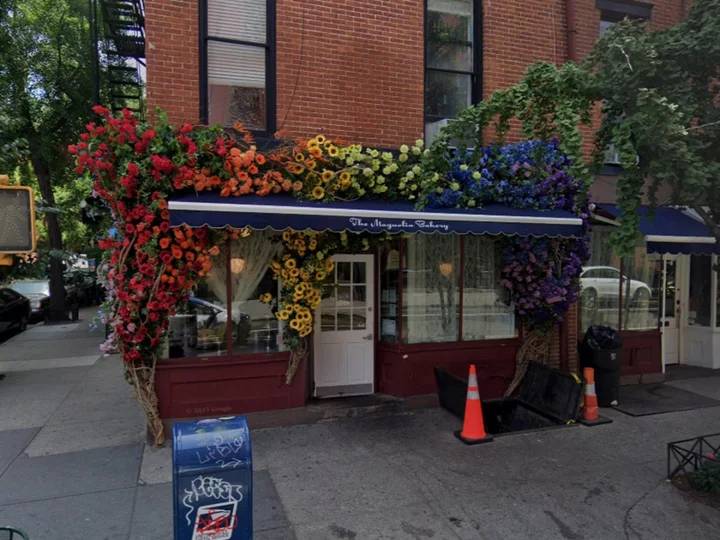
Several injured in stabbing outside Magnolia Bakery in New York’s West Village
A suspect is in custody after several people were injured in a stabbing near The Magnolia Bakery on Bleecker Street in Manhattan’s West Village, according to a report. A 911 call came in reporting an incident at W 11th St & Bleecker St, the Citizen website stated at 9.58am on Thursday morning. First responders arrived at the scene to attend to several stabbing victims with non-life-threatening injuries and officers called a Level 1 Mobilization and request for additional units as the search for the suspect expanded. Officers said that the suspect was a Black man wearing a gold chain and a navy blue shirt who fled the scene in the direction of an E train station, according to the site, which stated at 10.27am that officers reported having detained the suspect. The Independent has reached out to the NYPD for comment. Eli Klein, an art dealer and publisher according to his bio on X, the platform formerly known as Twitter, wrote shortly before 10am on Thursday that “Someone was just attacked in what looked like a stabbing a few feet away from me and my baby girl here in Manhattan’s West Village. NYC really needs to take broader steps to get violent criminals off of the streets”. “Looks like he just went on to stab more people, unless this is a different criminal, which wouldn’t surprise me. My description of the attacker I saw is: Black, male, 30s, 5’10, gray outfit,” he added in reference to the Citizen report. More follows...
2023-07-27 23:23
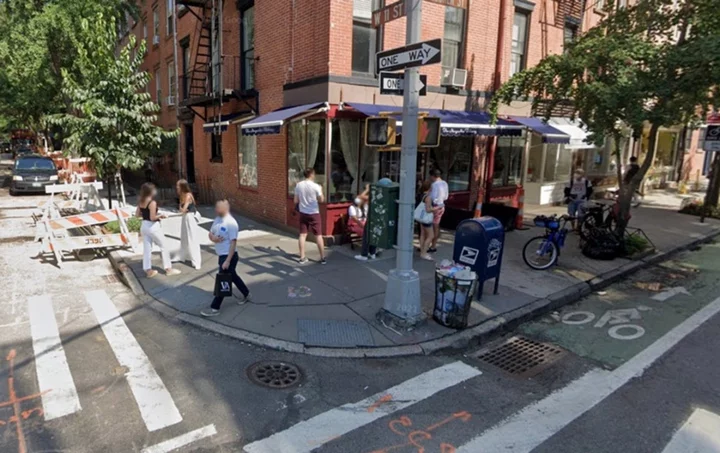
West Village stabbing - live: Multiple people injured in attack near NYC’s Magnolia Bakery
Multiple people have been injured in a stabbing in New York City’s West Village that took place on Thursday morning, reports say. Initial reports suggest that the incident occurred outside the famous Magnolia Bakery on the corner of W11th Street and Bleecker Street in the heart of the wealthy neighbourhood on the west side of Manhattan. It is not clear how many people have been injured in the stabbing, but their injuries are not believed to be life-threatening. Reports on the Citizen app indicate that police quickly apprehended a suspect shortly after releasing a brief description of him as an African American male in a navy shirt and gold chain. More follows...
2023-07-27 23:22
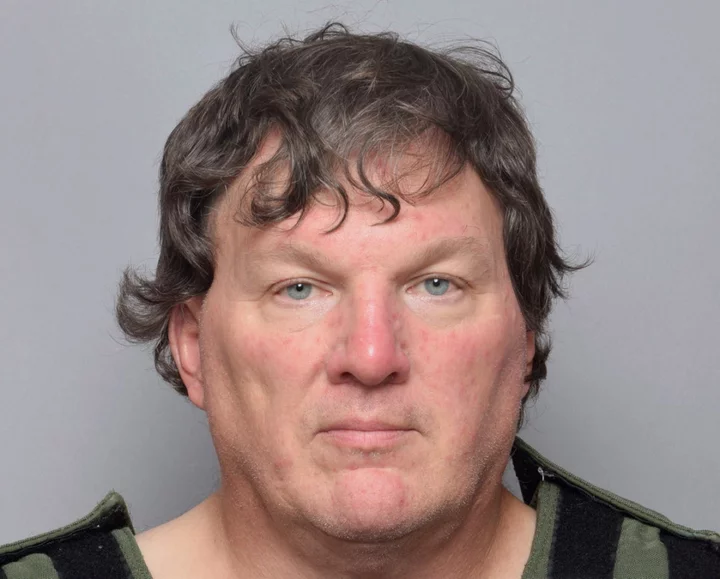
Gilgo Beach witness questions why it took so long to make arrest after he gave tip that cracked case in 2010
Rex Heuermann’s arrest came as a shock to nearly everyone in the Long Island community of Gilgo Beach – but not for a man who came face to face with the alleged murderer and had reported him to law enforcement. For more than a decade, residents anxiously awaited new developments on a trail of murders that had gone cold, despite overwhelming evidence the slayings were the work of a serial killer. Most of the victims were sex workers in their 20s who went missing in 2009 and 2010 before their bodies were discovered wrapped in burlap along the stretch of a roadway. The Suffolk County police department led an unsuccessful 13-year investigation into the case amid a litany of internal scandals, before announcing earlier this month that Mr Heuermann was in custody. Police commissioner Rodney Harrison touted the work of a revamped task force as the reason behind the arrest, but largely glossed over the fact that the very detail that cracked the case was handed to authorities in the early stages of the probe. Dave Schaller told the Associated Press in an exclusive interview that, by the time Mr Heuermann’s mugshot was plastered on every local and national news channel on 13 July, he was very familiar with the Frankenstein-like figure with an “empty gaze” he had long ago described to investigators. In the winter of 2010, Mr Schaller told police that he had seen the man fleeing the house he shared with Amber Costello, whose body was among those found in Gilgo Beach. “When they told me she was dead, he was the first person who jumped in my head,” Mr Schaller told the AP. “I’ve been picturing his face for 13 years.” Mr Heuermann met with homicide detectives on multiple occasions during the initial years of the investigation. Two years after the bodies were found, Mr Schaller said he picked Mr Heuermann’s first-generation Chrysler Avalanche out of a line-up of photographs provided by the detectives. “I gave them the exact description of the truck and the dude,” Mr Schaller, who said he was angered by the delay in investigating his tip, told the AP. “I mean come on, why didn’t they use that?” Suffolk County district attorney Ray Tierney, who inherited the investigation when he took office in 2022, said the key to unravelling the case was the description of the truck, rediscovered by a state investigator after the launch of the new task force that took a fresh look at the evidence. Mr Tierney told the AP he did not know why police had not run a search earlier, but suggested the tip may have been “lost within a sea of other tips and information”. He stressed there were other elements that ultimately helped investigators arrest Heuermann, including new technology that helped match samples of DNA to the suspect. “This was a dark cloud over the community,” former police commissioner Tim Sini, who later became the county’s district attorney. “When you have the police department and the district attorney’s office blocking the FBI, that does not engender trust in law enforcement.” The arrest, Sini said, was the result of painstaking detective work that spanned multiple administrations and relied on a wide range of evidence. “[However,] I wouldn’t call it a major success. The case should’ve been solved earlier,” he said. “This was crucial information, and I don’t know why they didn’t share it,” Rob Trotta, a county legislator who worked as a Suffolk County police detective until 2013, also told the AP. “They made some serious blunders here.” Two high-ranking officials who worked closely on the case and attended briefings between 2011 and 2013 told the AP they never heard Mr Schaller’s witness statement. Mr Heuermann bought the pickup at a Chevrolet dealer on Long Island in 2002 and transferred ownership to his brother Craig in South Carolina in 2012. Authorities seized the vehicle last week. A search warrant stated investigators were looking for other clues in the vehicle or at property the brothers owned in Chester County, such as DNA, fluids, fingerprints, phones and what they described as possible “trophies” that may have belonged to the victims. Mr Heuermann is charged with the murders of Amber Costello, Melissa Barthelemy and Megan Waterman. He is also the prime suspect in the murder of Maureen Brainard-Barnes. As law enforcement closed in on Mr Heuermann, they served more than 300 subpoenas and search warrants that uncovered cellphone records for burner phones used to arrange meetings with three of the “Gilgo Four” victims before they went missing. Further analysis also allegedly linked Mr Heuermann to taunting calls made to family members of the victims, according to investigators. The calls were made from the Midtown Manhattan area, where the offices of Mr Heuerman’s architecture business are located. Among the evidence linking Mr Heuermann to the murders was a hair found on burlap material used to wrap Waterman’s corpse, according to court documents. DNA analysis had not been possible in the early stages of the investigation, but new technology allowed testing. A team surveilling Mr Heuermann collected a discarded pizza box that then confirmed a DNA match with the suspect on 12 June. Records also showed several online accounts under fictitious names linked to Mr Heuermann were used for illegal activities. Mr Heuermann allegedly used those accounts and burner phones to contact women for prostitution services, as well as making chilling online searches. The searches included sadistic, torture-related pornography, child pornography and disturbing content. Mr Heuermann is also accused of searching “why could law enforcement not trace the calls made by the long island serial killer,” “why hasn’t the long island serial killer been caught” and “new phone technology may be key to break in case”. Mr Heuermann has pleaded not guilty to all the charges against him. Authorities in New York, New Jersey, Connecticut, Las Vegas and South Carolina are looking into possible links between Mr Heuermann and unsolved cases. The Associated Press contributed to this report Read More Missing paddle boarder’s body pulled from Martha’s Vineyard pond next to Obama mansion Manhattan architect, family man and accused serial killer: Who is Gilgo Beach suspect Rex Heuermann? How the Gilgo Beach serial killer turned the Long Island shore into a graveyard
2023-07-25 18:16

Carlee Russell sent several bizarre tweets before fake ‘disappearance’
Before 25-year-old Carlee Russell went missing for a mysterious 49 hours – a disappearance, she admitted on Monday, that was staged – she posted a series of bizarre tweets. On the day she went “missing” on 13 July, she tweeted at 8.55pm: “today was a GREAT day God be looking out im telling you!!” One minute later, Ms Russell wrote: “someone to tell you ‘i love you’ and don’t got a reason.” Finally, she tweeted, “yeah i want a family now” at 9.19pm. Just moments later, around 9.30pm, the Alabama woman called 911 and told detectives that she was following a lost toddler along the interstate. After she returned home, Ms Russell claimed was abducted by a man with “orange hair,” before escaping. She later turned up on foot at her parent’s home with $107 tucked in her right sock, and alleged she had barely survived the encounter. Her tweets, in combination with her search history prior to her vanishing, raised doubts about the Alabama woman’s story. Police revealed that Ms Russell’s internet search history gave hints she could have staged her own kidnapping, as she looked up Amber Alerts, the movie Taken, booking a bus ticket from Birmingham to Nashville and “how to take money from a register without being caught.” A tweet on 10 July adds colour to this complicated picture, and indicates potential problems in her relationship. Ms Russell wrote, “I always say one thing i WONT do is stay with someone who cheated on me like you went and had sex with someone else and think it’ll be sweet one day?? hellll no.” Days earlier, she also tweeted: “everyone wants to feel wanted.” Her boyfriend, Thomar Latrell Simmons, had posted on Facebook upon Ms Russell’s miraculous return, and supported her story that she had been abducted. She had been “fighting for her life for 48 hours,” he wrote, but has since taken down the post. Two days earlier, her tweet revealed she may have been unhappy at work: “my job is really starting to get on my dang nerves.” She worked at Woodhouse Spa, the owner of which said on Thursday that he provided the police with “everything we uncovered.” According to the New York Post, Ms Russell tweeted on 19 July, “I’m thankful I know how to identify when the enemy coming for me now, makes life a lot easier.” But the post has been taken down. Police began expressing their doubts last week, saying Wednesday they were “unable to verify” most of Ms Russell’s claims regarding the events leading up to and during her disappearance. Read More Carlee Russell – latest: Confusion reigns over ‘kidnapping’ case after missing woman’s search history revealed Carlee Russell claimed she was kidnapped by a man with orange hair. Police say they can’t verify any of it Carlee Russell’s internet searches suggest she staged her own kidnapping, Alabama police say
2023-07-25 07:54
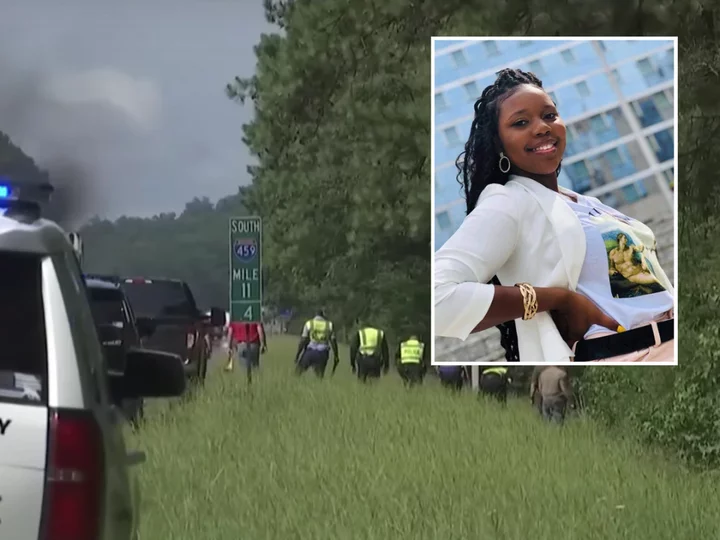
Carlee Russell – latest: 'Kidnap victim' admits to lying about abduction and toddler in distress
Carlee Russell’s story about being abducted after stopping at the side of a road to help a distressed toddler was a lie, her lawyer has said in a statement. The 25-year-old from Alabama told police she was kidnapped after stopping to help a toddler in diapers who was walking alone on Interstate 459 on the evening of 13 July. She came back home two days after the alleged abduction. Her family had stuck by her story, even after police publicly expressed scepticism. However, Hoover Police Department Chief Nicholas Derzis on Monday said Ms Russell’s attorney, Emory Anthony, had now provided a statement on Monday saying there was no kidnapping The statement in part read: “There was no kidnapping on Thursday July 13. My client did not see a baby on the side on the road.” Earlier CrimeStoppers walked back a pledge to return almost $63,000 in donations to help find Carlee Russell after the 25-year-old’s kidnapping story fell under suspicion. More than $63,000 was raised during the two-day search for the Alabama woman. But the organisation that offers anonymous tips about criminal activity now said the money will not be returned after initially making the promise. Read More Carlee Russell sent several bizarre tweets before disappearing Alabama lawyer says police is using ‘every other synonym for lie except saying she lied’ in Carlee Russell case Boyfriend of Carlee Russell deletes social media posts after police cast doubt over her kidnapping story Police doubt Carlee Russell’s kidnapping claims. Could she face consequences?
2023-07-25 06:18
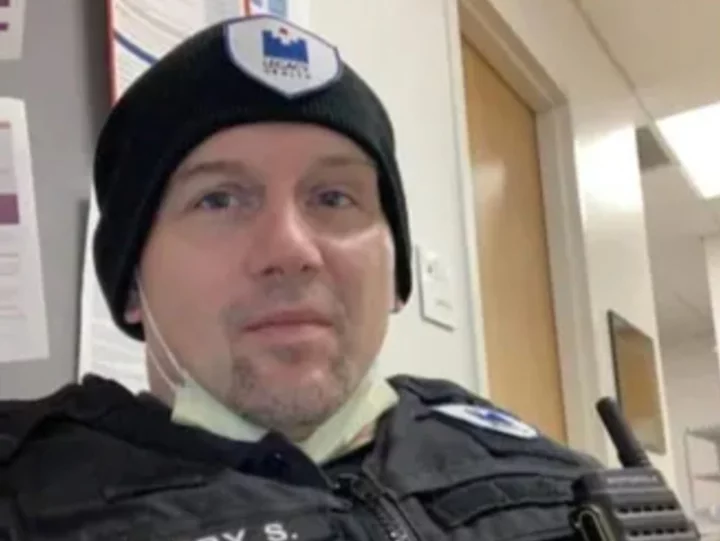
Hospital security guard fatally shot while on the job by suspect later killed by Portland police
An on-duty security guard was fatally shot at a hospital in Oregon by a suspect who was later killed by police. Forty-four-year-old Bobby Smallwood was working at the birthing centre of Legacy Good Samaritan Medical Center in Portland when the tragic events unfolded around 11am on Saturday. A suspect who has yet to be identified entered the building armed with a firearm and shot Smallwood and another hospital worker before fleeing the scene, according to the Portland Police Bureau. As terrified staff followed shelter-in-place protocols, Smallwood was transferred to a trauma facility, where he was pronounced dead. The second victim remains in stable condition, police said. Police said that officers responding to the scene set up a perimeter around the neighbourhood and attempted to locate the suspect. Officers also evacuated and searched a Fred Meyer after learning information that suggested the shooter may have been inside but he was not found. The suspect’s car was eventually traced to the city of Gresham, about 16 miles east of Portland. He was killed by law enforcement after his vehicle was stopped. The motive behind the shooting is still unclear. “During the incident, shots were fired by police. The suspect is deceased. No officers were injured,” a statement by the Portland Police Bureau read. On social media, coworkers remembered Smallwood as a devoted security guard. “I remember him fondly from his early days as a COVID screener in our building at Mt. Hood. What a sacrifice he made protecting others,” Elana Schaff, who worked with Smallwood at Legacy Mt Hood Medical Center, wrote in a Facebook post. “My heart is there with everyone who had to endure this insane situation.” Smallwood’s family has created a GoFundMe page to raise funds for funeral costs. Mr Smallwood’s father Walter Smallwood told The Oregonian that his son enjoyed being surrounded by children at the hospital and wasn’t fearful of his job, despite not being armed. “He loved children. Adults, he tolerated,” Mr Smallwood said. “He wasn’t [scared about the job]. I was.” Smallwood had initially done administrative and computer work at Legacy Health after graduating from Portland State University in 2020. His parents told Oregon Live that he had recently been promoted to a supervisory role. “This is a sad day for the staff at Legacy Health, and our hearts go out to the family, friends, and coworkers of the employees affected by today’s tragedy,” Chief Chuck Lovell, who responded to the scene, told The Associated Press. “By all accounts, hospital staff and law enforcement did great work responding to this incident, and I’m grateful for the coordinated efforts by all.” Kathryn Correia, Legacy Health president and CEO, also said in a statement: “Words cannot express the profound grief we are experiencing. “We offer our unwavering support to Bobby’s loved ones, to our patients in our care, to the staff at Legacy Good Samaritan and to all our employees and providers suffering today.” Read More Joe Biden is breaking his promise to end the federal death penalty Lauren Boebert blames her AirPods after she threw away photo of 10-year-old Uvalde victim Gunman who killed co-workers at New Zealand building site died from self-inflicted wound, police say
2023-07-25 03:57
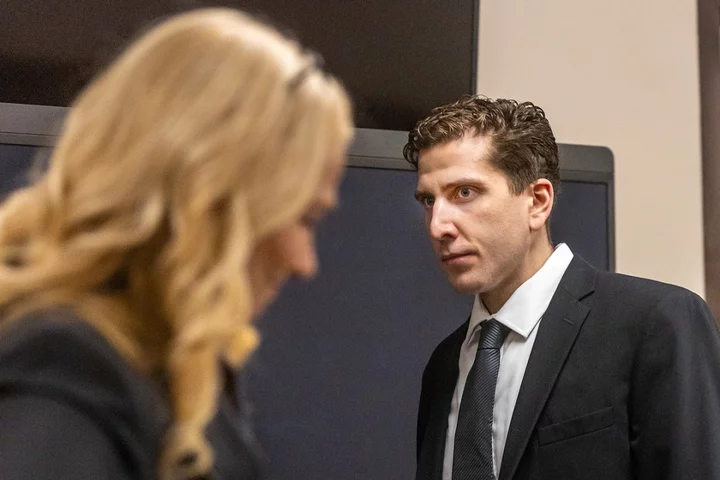
Bryan Kohberger claims DNA may have been planted at Idaho murders scene – as alibi deadline looms
Bryan Kohberger has claimed that the DNA evidence tying him to the brutal murders of four University of Idaho students may have been planted at the crime scene – as the deadline for him to give an alibi for the slaying looms. In a recent court filing in Latah County Court, the 28-year-old criminology student suggested that police officers could have somehow placed his DNA on the knife sheath which was left behind by the killer at the college rental home in Moscow, Idaho. “The State’s argument asks this Court and Mr Kohberger to assume – is that the DNA on the sheath was placed there by Mr Kohberger, and not someone else during an investigation that spans hundreds of members of law enforcement and apparently at least one lab the State refuses to name,” Mr Kohberger’s attorneys wrote. Prosecutors fired back at the suggestion that the evidence was “rigged”, writing in a filing that “the State is at a loss as to how that theory supports a claim that the lGG information is material to the preparation of his defense”. Mr Kohberger was tied to the 13 November murders of Madison Mogen, Kaylee Goncalves, Xana Kernodle and Ethan Chapin through a knife sheath left at the scene. The sheath – for a military or Ka-Bar style knife – was found partly under Mogen’s body after she and Goncalves were found stabbed multiple times on Mogen’s bed on the third floor of the home. DNA on the button clasp of the sheath was then found to match that of the 28-year-old accused killer. Mr Kohberger’s attorneys have sought to cast doubts on the strength of this DNA evidence, in particular the use of genetic genealogy. According to the affidavit in the case, the FBI used genetic genealogy databases to try to identify the DNA source. Trash was then collected from the suspect’s parents’ home in the Poconos Mountains and a familial match – from Mr Kohberger’s father – was made to the sheath, according to the criminal affidavit. Following Mr Kohberger’s arrest on 30 December, DNA samples were then taken directly from the suspect and came back as “a statistical match”, say prosecutors. Mr Kohberger’s attempts to cast doubts on the evidence come ahead of a looming deadline for the accused mass killer to offer an alibi for the night of the murders. Under Idaho law, defendants have 10 days to provide a written statement about where they claim to have been at the time of the alleged crime and offering information about any witnesses who can support their claim. On 23 May – one day after he was arraigned on four murder charges – Latah County Prosecutor’s Office put in a demand for Mr Kohberger’s notice of alibi. Back then, Mr Kohberger’s legal team asked Judge John Judge for an extension to this deadline, saying that they needed more time due to the wealth of evidence in the high-profile case. The judge extended the deadline through to 24 July. As of Monday morning, the Idaho cases of interest website – where the latest filings in the case are shared – had gone down. Mr Kohberger is facing the death penalty if convicted of the murders of Goncalves, 21, Mogen, 21, Kernodle, 20, and Chapin, 20. He is scheduled to stand trial on 2 October after being indicted by a grand jury on four counts of first-degree murder and one burglary charge. Mr Kohberger is accused of breaking into an off-campus student home on King Road in the early hours of 13 November and stabbing the four students to death with a large, military-style knife. Two other female roommates lived with the three women at the property and were home at the time of the massacre but survived. One of the survivors – Dylan Mortensen – came face to face with the masked killer, dressed in head-to-toe black and with bushy eyebrows, as he left the home in the aftermath of the murders, according to the criminal affidavit. For more than six weeks, the college town of Moscow was plunged into fear as the accused killer remained at large with no arrests made and no suspects named. Then, on 30 December, law enforcement suddenly swooped on Mr Kohberger’s family home in Albrightsville, Pennsylvania and arrested him for the quadruple murders. The motive remains unknown and it is still unclear what connection the WSU PhD student had to the University of Idaho students – if any – prior to the murders. However, the affidavit, released in January, revealed that Mr Kohberger was tied to the killings through his DNA on the knife sheath, surveillance footage showing his white Hyundai Elantra close to the crime scene and cellphone activity. The murder weapon – a fixed-blade knife – has still never been found. As a criminal justice PhD student at WSU, Mr Kohberger lived just 15 minutes from the victims over the Idaho-Washington border in Pullman. He had moved there from Pennsylvania and began his studies there that summer, having just completed his first semester before his arrest. Before this, he studied criminology at DeSales University – first as an undergraduate and then finishing his graduate studies in June 2022. While there, he studied under renowned forensic psychologist Katherine Ramsland who interviewed the BTK serial killer and co-wrote the book Confession of a Serial Killer: The Untold Story of Dennis Rader, the BTK Killer with him. He also carried out a research project “to understand how emotions and psychological traits influence decision-making when committing a crime”. Read More Bryan Kohberger’s criminology professor weighs in on Rex Heuermann’s arrest in Gilgo Beach murders probe Plan to demolish home where four University of Idaho students were murdered is delayed Bryan Kohberger could face the firing squad for the Idaho murders. What would this mean?
2023-07-24 19:47
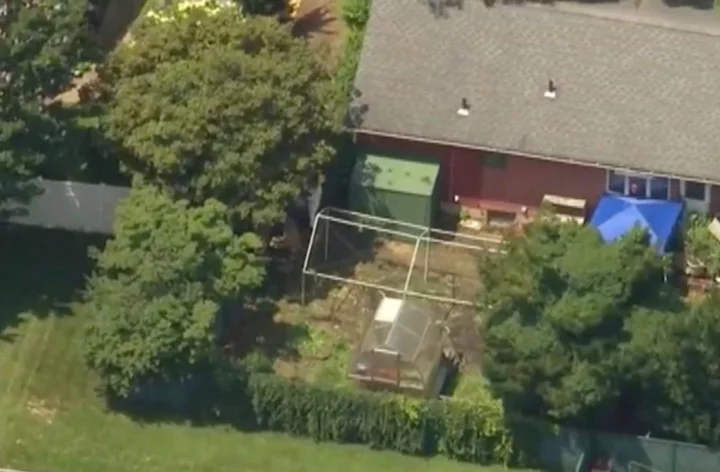
Excavator spotted digging at Gilgo Beach serial killer suspect’s home amid reports of ‘sound-proofed basement’
Investigators have been spotted digging up the backyard of Rex Heuermann’s home amid reports that the Gilgo Beach serial killer suspect may have killed at least one victim inside a sound-proofed room in his basement. Search teams carried out what was described as a “major excavation” on Sunday at the one-storey home in Massapequa Park, Long Island, where the 59-year-old architect lived with his wife and two adult children. Cadaver dogs and a ground-penetrating radar machine were brought in to scour the ground before excavators were seen digging up the earth with a backhoe. At one point, a huge wooden deck was dismantled and a blue tent was erected to shield the search from view. A neighbour told The New York Post on Sunday that authorities had found a sound-proofed room in the basement of the home and that Mr Heuermann is believed to have killed at least one of his victims down there. “He’s got a soundproof room in his basement,” Robert Musto, a 64-year-old longtime neighbour said he had been told by law enforcement on the scene. “What do you think that was for? They’re saying there’s evidence he killed at least one of the girls down there. “The cops are going to dig all that out. Said they’re focused on the soundproof room in the basement but they’re going to look at everything.”A former coworker confirmed the existence of a soundproof basement room to the paper, claiming that the accused serial killer once took time off work in order to carry out the bizarre construction of the vault in his family home. The individual, who was not named, recalled Mr Heuermann building the concrete-lined vault which is around two to three feet thick. “it’s not just a hidden room – it’s a serious vault,” they said. “It had a huge heavy-duty safe door. He went and poured new concrete walls, massive amount of concrete to encase this room. It was maybe 2 or 3 feet thick.” New York officials have not confirmed the existence of the sound-proofed basement room or publicly said that they believe Mr Heuermann may have killed one or more victims in the room. However, officials are probing the possibility that the accused serial killer killed the victims inside his family home. His wife and two children were out of town at the time of each of the three murders he is charged with. Law enforcement sources previously told CNN that a vault of some sort had been located in the basement of the Massapequa Park home – and that a trove of up to 300 firearms had been found inside. The married father-of-two had 92 legal gun permits and was a keen hunter, according to police. In the 11 days since Mr Heuermann was arrested in connection to the infamous serial killer case, investigators have been searching for evidence tying him to the murders including any trophies taken from the victims. As well as extensively searching his home, officials are probing other locations connected to the accused murderer including storage units two miles away in Amityville. Meanwhile, law enforcement agencies are also looking into unsolved murders and missing persons cases all across America including in Las Vegas, South Carolina and Atlantic City. Over in South Carolina, Chester County Sheriff’s Office said that they were looking for evidence to assist New York officials. “The Chester County Sheriff’s Office was requested by the Gilgo Beach Task Force to assist in gathering evidence in Chester County relevant to their investigation,” the department tweeted. Mr Heuermann owns a property in Chester next to his brother Craig. The pickup at the centre of the murder investigation was seized from his brother’s home last week. Mr Heuermann was arrested on the night of 13 July when a team of officers swooped as he left his office in Midtown Manhattan where he ran an architecture business. He was charged with three counts of murder in the first degree and three in the second degree over the deaths of Megan Waterman, Melissa Barthelemy and Amber Costello. He is also the prime suspect in the murder of Maureen Brainard-Barnes – who together with the three is known as the “Gilgo Beach Four” and was last seen alive in early June 2007 in New York City. The four women were found within one-quarter mile of each other, bound by belts or tape and some wrapped in burlap – their bodies dumped along Gilgo Beach. He has pleaded not guilty to the charges and is being held without bond. Court records show that Mr Heuermann was linked to the killings through a pimp’s tip about his pickup truck, a stash of burner phones, “sadistic” online searches, phone calls taunting victims’ families, his wife’s hair found on the victims’ bodies – and a pizza crust. The first piece of the puzzle came when a witness in the Amber Costello case revealed details about a vehicle that a client was driving when she was last seen alive. Costello, who worked as a sex worker, was seen alive on the evening of 2 September 2010 when she left her home in West Babylon. A witness said she had gone to meet a client who was driving a first-generation Chevrolet Avalanche. Last year, a registration search showed that local man Mr Heuermann owned a first-generation model of the truck at the time of Costello’s disappearance. He also matched the witness’ description of the man believed to be the killer: a large, white “ogre”-like male in his mid-40s, around 6’4’ to 6’6” tall, with “dark bushy hair,” and “big oval style 1970’s type eyeglasses”. The discovery of the car led investigators to hone in on Mr Heuermann including executing 300 subpoenas, search warrants and other legal processes to obtain evidence to determine his potential involvement in the killings. Among this was Mr Heuermann’s alleged use of burner phones, with prosecutors saying that he used burner phones to contact the three women and arrange to meet them at the time when they went missing. He also allegedly took two of the victims’ cellphones – and used one to make taunting phone calls to one of their families where he boasted about her murder, court documents state. Mr Heuermann’s DNA was found on one of the victims, while his wife’s hairs were found on three of the four women he is connected to. His arrest comes after the horrific serial killer case has captured the nation’s attention for more than a decade. The Gilgo Beach murders had long stumped law enforcement officials in Suffolk County who believed it could be the work of one or more serial killers who targeted sex workers and dumped their bodies along the remote beaches on Ocean Parkway. The case began in May 2010 when Shannan Gilbert vanished after leaving a client’s house on foot near Gilgo Beach. She called 911 for help saying she feared for her life and was never seen alive again. During a search for Gilbert in dense thicket close to the beach, police discovered the remains of another woman. Within a matter of days, the remains of three more victims were found close by. By spring 2011, the remains of a total of 10 victims had been found including eight women, a man, and a toddler. Police have long thought that it could be the work of one or more serial killers. Gilbert’s body was then found in December 2011. Her cause of death is widely contested with authorities long claiming that it is not connected to the serial killer or killers but that she died from accidental drowning as she fled from the client’s home. However, an independent autopsy commissioned by her family ruled that she died by strangulation and her mother believes she was murdered. Like Gilbert, most of the victims targeted were sex workers while some are yet to be identified. Read More More families await answers in Gilgo Beach killings – and the names of other victims Pizza crust, burner phones and his wife’s hair: How Long Island police tied Rex Heuermann to the Gilgo Beach murders BTK killer makes chilling comparisons between himself and Gilgo Beach murders suspect Rex Heuermann
2023-07-24 17:21
